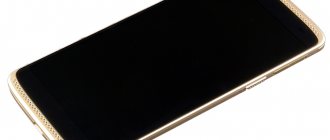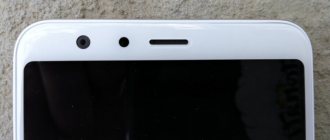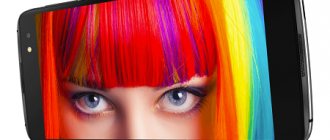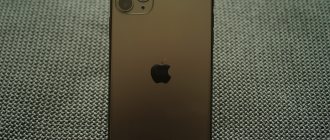If you have been following the smartphone market for several years, you have already seen the concept of foldable devices. For example, one of these was offered by Samsung, where a single screen unfolded in the middle, as a result of which a small tablet turned into a classic smartphone and vice versa.
The new ZTE Axon M is based on the same idea, but the implementation is much more straightforward. We can say that this is a foldable Android tablet with two screens, the diagonal of each of them is 5.2 inches, and they are connected to each other by hinges.
This is not a concept or a prototype. The smartphone is already available for purchase. It has a good set of characteristics, including a Snapdragon 821 processor, 4/64 GB of memory, and a glass and metal body. Is it safe to say that the Axon M is a powerful device for multimedia and multitasking, or is the dual screen just a quirk? Let's figure it out.
Design
The Axon M isn't likely to win any awards for its innovation or unusual looks, but it still looks unique. You might remember the Kyocera Echo from 2011, but it was a plastic smartphone from a different time.
The Axon M breathes new life into this form factor, using a combination of metal and glass, with sharp edges that make it comfortable to hold in your hand. It is a thick smartphone, about 12mm, with two screens and weighs 230g, which is 30g more than the iPhone 8 Plus.
In any orientation, this device takes some getting used to, but the earpiece, flash and camera, which is both front and back here, tell you where the front part is.
When the smartphone is used as usual, you immediately notice the heaviness. However, the first problem is trying to unlock the smartphone. All buttons are located on the left side. There's a quick-release button for the camera, a volume rocker, a power button, and a fingerprint scanner, while the hinges are on the right.
Unfortunately, that side-mounted fingerprint scanner is too small of a target and also on the wrong side for right-handers. As a result, you press at an awkward angle and the scanner often does not work.
The problems continue when unfolding the smartphone. In landscape position, with the two screens open side by side, the frames provide enough space to hold the smartphone in your hands.
This is great for scrolling on websites. In games and when watching videos, everything is not so convenient when two screens are used as one large one. This is one of the two main application modes, which the developers call Extended Mode.
Fingers are placed awkwardly to reach the control buttons on the screen. There is also a strange black bar at the bottom in the middle of the screen. Your hand covers the speaker at the bottom, which also ruins games. It's difficult to find a comfortable grip, so it's best to play on one screen in landscape orientation, which is what these games were designed for.
It's too bad that the ZTE Axon M performs poorly in games, since the smartphone could be an excellent device for gamers. Imagine an option in which the game itself is shown on one screen, and the other turns into a gamepad.
There are big doubts that game manufacturers will optimize them specifically for this smartphone. Otherwise, the advanced mode works great in a situation where you can hold the smartphone with one hand and operate the interface with the other.
The quick launch button, when pressed twice, activates the camera, you can choose between video services YouTube, DirecTV, HBO GO and others (if they are available in your country). This feature is called TV Mode.
The button protrudes clearly from the body, as does the volume rocker, but they are located quite low on the left side, so accidental presses are common when holding the smartphone in landscape mode, with one or two screens. You can also remember a flashlight that, when turned on, immediately tries to blind you.
Impression
If you buy a ZTE Axon M, it is better to immediately have a pair of glasses for the screens. Although both displays are protected by Gorilla Glass 5, you instinctively worry when you put it in your jacket pocket along with your keys. On the other hand, the screens have an excellent oleophobic coating, and I wouldn’t want to lose it.
Holding the smartphone in your hand is quite comfortable; opening the smartphone is also no problem: just pick up the slightly protruding end of the thin part with the second display. We discovered a big advantage for those who like to watch videos: you can put the ZTE Axon M on the table “in a house” and calmly enjoy your next TV series while having breakfast. Other smartphones will require a stand.
It's better to enjoy two screens at once in a quiet environment. In the subway, holding an open smartphone is not very convenient; in a car, in order to fit it into the holder, you still have to be content with one.
The camera is excellent, quite sharp, and works quickly. Selfies can be taken easily, but to take pictures of those around you, you need to turn the smartphone towards you with the second screen. The image will “jump” from one display to another. You quickly get used to such an unusual scheme, but at first it seems terribly inconvenient.
There are a moderate number of “beautifiers” - where would we be without them? Contrast and brightness can be adjusted using sliders on the shooting screen. When the camera is used as the main one, the most interesting mode is Pro, which has control over almost all the main functions (ISO, exposure, shutter speed, etc.).
Screen
Each of the two 5.2-inch screens has a 1080p resolution, and together the diagonal grows to 6.75 inches. Detailing is at a good level, viewing angles are also good, but there is a yellowish tint. The sample in question had a dimmer second screen compared to the main one.
When you watch a video in extended mode, you can't help but notice the obtrusive black bar in the middle. Otherwise, the independent use of two screens is quite good; you can watch different sources or display the same thing on each screen.
Axon M will soon be released in Russia - interview with ZTE top manager
While working at the MWC 2020 mobile exhibition, I went to the exhibition stand of the Chinese company ZTE, where I assessed the new Blade V9 smartphone, looked at the foldable Axon M, and also interviewed a company representative, Jacky Zhang, head of the terminal division of ZTE Mobile Devices in countries of Asia and the CIS. He answered our questions and also spoke about the future of the brand in Russia and the CIS.
Telegram channel of the creator of Trashbox about technology
- Hello. We are glad to see ZTE at the Mobile World Congress 2020. Readers of Treshbox.ru will be interested in learning more about your company and the latest innovations presented here in Barcelona... Also, do not forget about future plans for our home market - Russia and the CIS. Our first and main question is exactly this - how do you plan to develop in this region this year and in the future?
— Russia is a strategic market for us. This year we plan to make several important launches for it. Our goal is to become one of the top 5 smartphone manufacturers in this region. We already have good relations with Russian partners, but we still have to develop our own marketing.
However, marketing is only part of success; the main thing is the product. That's why we're preparing some cool launches. Having presented important new products, we plan to strengthen cooperation with many distribution companies so that the devices are present in even more stores.
— Some companies open their own stores. Are you planning something similar in Russia?
— First, we need to establish cooperation with common distribution channels, increase investments in marketing, and make the brand more recognizable. We will do this step by step, gradually. And only then you can think about opening your own stores in Russia.
— Regarding the various lines of ZTE smartphones. I remember that you have the Blade and Axon lines. Are you planning to open any other directions or will you focus on these two?
— We have plans to reformat the line of smartphones in the ABC order, that’s what we call it. This means Axon, flagship smartphones with powerful hardware. B - Blade, more affordable devices aimed at the middle and budget price categories. C - Cloud, is a cloud service and connection, mainly focused on the Internet of Things (IoT) and on-board technology. These are three important areas; there will be no others.
— As far as I know, you also sell regular telephone dialers. How important is this category of devices for you and what are your plans for Russia from this point of view?
“For many people, especially in developing countries, such phones are very important, they are loved and used. But at the same time, they are much easier to develop than smartphones. That's why we still pay attention to such a category as dialers. We don't plan to give it up.
— Also, you are not afraid of experiments. For example, not long ago ZTE released a foldable smartphone - Axon M. How do you see the future of such gadgets?
— The smartphone market is now quite monotonous, so we decided to do something new, unlike other gadgets. Already, Axon M is a recognizable device around the world. This is a fairly popular model in China and Japan. The Axon M example shows how ZTE can defy current trends while still delivering value to consumers. For many people, the Axon M is the ideal device due to its dual-screen capabilities. It can be used as a tablet and as a regular smartphone, work with two applications at the same time, and be more multitasking.
— Are you planning to bring ZTE Axon M to Russia? As far as I remember, this model is limited in sales.
— We have already launched this smartphone in the USA and Japan, as well as in the European market (in Italy and Spain). This is a very good result for a Chinese company - few can afford such an innovative product. Therefore, we will release Axon M in Russia. I think that such a model will be very warmly received there. In Japan, this gadget is selling very well, and similar success is possible in Russia.
— We hope that the second generation of Axon M will also visit Russia.
— Moreover, we are thinking about releasing a flexible smartphone! And the second generation of Axon M received a lot of funding - we believe in this project.
— When is the release of Axon M planned in Russia?
— Most likely, this will happen before the third quarter of 2020. It is quite possible that Russia will even receive a special version with optimizations for this region.
- Let's move on to your new product - ZTE Blade V9. What are the goals of this model? Who is it for? What did you focus on?
— It’s worth starting with the fact that Blade V9 will appear in Russia in mid-April. We are also preparing a special version of Blade V9 for this market with slightly different characteristics and positioning. An interesting feature of the V9 model: it has NFC, although we do not use this technology in China.
Martha
— What plans does your company have for producing accessories, such as smart watches or bracelets? Many companies are trying to create a whole ecosystem of devices. Do you like this strategy?
- All this is in the plans. We have extensive experience in terms of manufacturing accessories. In addition, we often collaborate with local operators and create customized gadgets for them.
— We know that ZTE is not only a well-known mobile brand, but also a strong company in the telecommunications and cloud technologies market. How do you see developments in this direction? When will 5G become a reality for the mass user?
— ZTE pays a lot of attention to the development of the fifth generation of cellular networks. In fact, we are one of the leading companies in this direction. In addition, ZTE received several awards for innovation in metro wireless networks at MWC 2018 and other conferences.
At the end of 2020 or early 2020, ZTE will release commercial 5G mobile terminals. 5G-enabled tablet PCs, telecommunications equipment, and smartphones are currently under development. The specific time to enter the market will correspond to the level of development of 5G networks among the world's leading operators. ZTE has entered the era of 5G network development and conducted tests in cooperation with leading operators around the world, including China Mobile, China Unicom, China Telecom, Japan's Softbank, Telefonica, Orange, T-Mobile, Wind Tre in Italy, Telenet in Belgium, Velcom , U mobile in Malaysia, and KT in South Korea.
One of the important features of 5G is support for NOMA technology, which will allow servicing several subscribers simultaneously. That's why 5G will be a big step forward - it's not just connection speeds that matter. ZTE regularly negotiates with Russian operators regarding the introduction of 5G.
“We hope that at the next MWC we will see commercial devices with 5G.
- Thanks for the questions! Perhaps we will see you again at the ZTE factory in Shenzhen. We will definitely invite you.
Interface and performance
Axon M runs on Android 7.1.2, the developers promise a quick update to Oreo 8.0. ZTE's own shell and applications are installed on top of Android. The design of the shell is not the most beautiful, it looks like stock Android, but sometimes even more colorless. The messenger has a boring green color that cannot be changed in the settings.
The most unique aspect of the interface is the simultaneous use of two screens. All available screen modes are activated through the M button, it is located in the navigation panel. There are the following operating modes:
- Single mode, when only the main screen works
- Dual mode, where two screens work independently of each other and can run two instances of the same applications, like Google Docs
- Extended mode, used to stretch content onto two screens, turning the smartphone into an analogue of a tablet
- Mirror mode, where the same content is displayed on both screens
The interface supports a set of gestures that make switching and managing applications easier. In dual mode, you can use a three-finger gesture across both screens to move an app from one screen to the other. It happens quickly and easily.
In advanced mode, you can promote content on one side to make room for another application. This is done with a simple one-finger gesture to the left side of the navigation bar. When you're done multitasking, you can swipe to the right and expand the left app to fill the screen again.
In terms of performance and fluidity, navigation is effortless, apps launch quickly and switch quickly. Unfortunately, the same cannot be said for switching between screens and their modes. The transition and response time leave much to be desired.
Characteristics of ZTE Axon M
Underneath the body is a Qualcomm Snapdragon 821 processor, the same one found in last year's Google Pixel. There is also 64 GB of internal memory and 4 GB of RAM. Performance is fast and consistent, despite the load the second screen puts on the system.
If you're short on storage space, the Axon M has a MicroSD card slot. But for wireless communication, Bluetooth 4.2 is used instead of the new Bluetooth 5 standard.
The Android 7.1.2 Nougat operating system works with the MiFavor launcher. The expected transition to Android 8.0 Oreo has not yet happened.
The 3180 mAh battery will last 28.7 hours of talk time. Qualcomm Quick Charge 3.0 fast charging technology allows you to charge it to 50% in 30 minutes using the included cable.
The ZTE Axon M has a camera only on the front panel - it is a 20-megapixel sensor with an f/1.8 aperture. Although the camera panel can be rotated back and the second screen can be used as a viewfinder.
Camera
The device was equipped with a camera with a resolution of 20 MP. As already mentioned, this is a single camera. When you launch the camera application, one of the two screens begins to function as a video finder (the main one when taking selfies, the rear one for normal shooting). Not the most convenient way to work with the camera.
The quality of the photos is also not good. In theory, a 20MP camera should provide great detail, but poor exposure and motion blur become an issue. The lack of optical image stabilization is also disappointing. These same shortcomings ruin 4K video.











